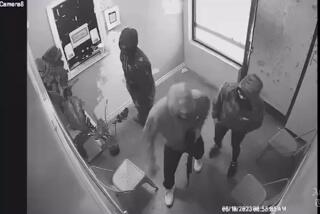Rape Case Detective Suspected an Officer : Crime: Victims’ descriptions of assailant’s behavior and failure of stakeouts led investigator to hypothesis, he says.
Sheriff’s Detective Floyd Feese remembers the moment he first suspected that he was tracking a fellow law enforcement officer.
It was late July, after the serial rapist whom Feese was hunting had struck the fifth time, and the San Diego County Sheriff’s Department had begun an elaborate surveillance operation at local beaches, complete with decoy deputies.
For three nights running, Feese had dispatched deputies in couples--one man and one woman--to walk the sands, hand in hand, in isolated stretches of coastline in Del Mar and Solana Beach. Given the attacker’s pattern of always striking couples or groups, it seemed the perfect trap. But it caught nothing.
“It became apparent that he was not striking the areas he should have been. At that point, we began to suspect a law enforcement officer,” the agent who investigated four of the attacks said last week after a San Diego police officer was arrested in a sexual assault case and named as the prime suspect in six other assault cases from Solana Beach to La Jolla.
Other things the victims remembered supported Feese’s hunch, he said: the way the attacker used his voice to control them; the way he stood in field interview stance--just out of reach, feet planted; the extreme care he took not to leave fingerprints; even the way he held his flashlight and his weapon. The biggest clue, Feese said, was that the attacker seemed to know the sheriff’s deputies’ next move.
“We were in communication with the San Diego Police Department throughout,” said Feese, who never told the San Diego police his theory that the attacker might be carrying a badge. On Thursday, when Henry Hubbard Jr., a San Diego police officer assigned to the northern patrol in the La Jolla area, was arrested, it all began to make sense to Feese.
“Officers working the northern area were aware of our operation,” he said, “including him.”
Hubbard, 29, was arrested Thursday on suspicion of attempting to rape a woman and attempting to kill her two male companions during an early morning robbery at Torrey Pines State Beach in La Jolla. Police say Hubbard shot the two young men when they tried to come to the woman’s aid. Hospitalized for wounds police say he suffered during the attack, Hubbard is scheduled to be arraigned Monday.
When told of Feese’s suspicions Friday, Sheriff Jim Roache said he was surprised.
“I’m going to be asking questions,” he said. Roache said he understood that a deputy would not want to begin making accusations about other law enforcement officials without evidence. “But still, it would have been nice to let somebody know.”
San Diego police officials felt the same way.
“Had it been the case that a law enforcement officer was suspected, that is certainly something that should have come to my attention or to the attention of our investigators, and it wasn’t,” Assistant Chief Cal Krosch said. “That’s the kind of thing we should have been made aware of.”
In an interview at the Encinitas substation Friday, Feese refused to discuss the evidence that his department, together with San Diego police, has collected against Hubbard.
From his knowledge of the seven cases, Feese was able to sketch out a profile of the attacker: a serial rapist who carefully chose his victims, taking special satisfaction in robbing young people of their ability to trust.
“Whoever committed these crimes is an evil person--simple as that,” Feese said, adding that the ages of the victims--all in their teens or early 20s--made this worse. “They were at that age when the world is opening up and everything is happy. This was wrong to destroy their image of life. And it also destroyed the image of law enforcement.”
Unknown to the public, Feese said, law enforcement officials had made the case a top priority. The reason, he said: Each attack was more abusive and violent than the last. Feese believed that it was only a matter of time before the gun would go off.
“We knew we had to catch this (guy). We knew it because we knew he was going to shoot someone,” he said. “It escalated in each case. Each one was a little kinkier. He would push a little harder, take a little more risk. . . . It did not appear that he was being satisfied. Especially near the end.”
After first attacking only couples, he gunman took the risk of confronting threesomes.
Feese’s probe began after the first attack, when a young couple was robbed on the beach in Del Mar at 3 a.m. on June 15. In that case, the assailant attempted to rape the woman, but she got away.
After the second attack, in Solana Beach on July 4, Feese said he began to believe there might be a serial rapist at work. In that incident, the attacker struck between 1 a.m. and 2 a.m., robbing a young couple on the beach and sexually assaulting the woman.
Once Feese suspected that the attacker was a serial criminal, he contacted San Diego police. There was one problem with his theory: When asked to describe their assailant, the victims seemed to have encountered different people.
When more attacks occurred, the discrepancies became more pronounced. For some reason--the dark locations of the attacks, the traumatic nature of the encounters--the victims’ descriptions of the attacker were vastly different.
“We had him varying from a white male, 5-foot-8, 150 pounds, to a white male, 6-foot-1, 200 pounds, to a black male 5-foot-10, 160 pounds, to 6-foot-4, 220 pounds,” Feese said. “There were two, three, four kinds of people. . . . The differences were the first thing that stood out. . . . And yet, under the surface, everything was similar.”
If he disregarded the physical descriptions, Feese realized, a pattern began to emerge. Always, the attacker wore a ski mask and dark clothing. He always struck on the beach after 1 a.m., always on a Thursday, Friday or Saturday morning. He always chose young couples or groups as his victims, and he often ordered the women to bind the hands and feet of their male companions with duct tape before attempting a sexual assault.
As the attacks continued--a third occurred July 6 in La Jolla, another in Solana Beach July 19 and another the next morning in La Jolla--investigators noticed other details as well.
“He was very cautious--more than a normal criminal,” Feese said. “He was very careful in having the female victim bind the male victim. Careful that he didn’t do it himself. Careful that he did not touch certain things. Careful in choosing the location and the type of people--young, inexperienced, easily intimidated and easy to control.”
The well-planned attacks all began the same way, Feese said. First, the assailant stalked the victims, determining the location of their vehicle. Often, he chose couples who were obviously romantically involved, Feese said.
When he confronted the victims, he first ordered them to give him their car keys, wallets or other property. The victims, frightened by the gun and by the man’s commanding manner, always complied with his requests. Maybe, they hoped, if they obeyed orders the man would rob them and leave.
“He always set that part up: a pattern of cooperation. The victims did not know what his intentions were,” Feese said.
Then the attacker--evidently very familiar with which beach access paths were closed at night--would lead his victims to darker, more remote locations, Feese said. Sometimes, after binding the male victims or ordering the women to do so for him, he would take the women a short distance away and attempt to rape them, Feese said. Five times, he succeeded.
“The male victims were devastated because of their inability to defend the women,” Feese said, speculating that the rapist enjoyed exercising control over both partners. “But it wasn’t their fault.”
In addition to displaying his handgun, which the attacker told victims he would not hesitate to use, the man used other methods to intimidate. His assertive way of issuing commands stuck in the victims’ minds, Feese said, as did his formal stance. As they described them, Feese said, these details reinforced his investigative team’s growing suspicion that they were looking for one of their own.
The suspicion had begun, Feese said, after the first three-night stakeout July 25--27. At one time, Feese had three man-woman decoy teams on area beaches. He had taken pains, he says, to choose young-looking deputies who fit the descriptions of previous victims. Because he expected any arrest attempt would result in a shootout, Feese also had specially trained officers on hand.
When the stakeout yielded nothing, Feese said, he began to wonder. When the victims described their attacker’s mannerisms, he wondered some more.
“In (the victims’) description of the actions, we became suspicious. . . . Certain things he said, the way he used his voice, the way he held his flashlight,” Feese said. “A cop can recognize another cop when he sees him. All cops stand the same way.”
Feese became more secretive about whom he told about the next stakeout, he said.
He hesitated to spread what was only a hunch--especially because another local law enforcement officer had recently been killed while robbing a home.
“It was (just) our speculation. We had no evidence to that effect,” Feese said.
Officials say the sixth attack occurred at 2:17 a.m. on Aug. 10. Again, the assailant chose a young couple on the beach in Del Mar. This time, when the man attempted to rob them, the victims were able to flee.
By this time, a team of Department of Justice investigators had come from Sacramento to profile the assailant. Investigators were particularly interested in the unusual aspects of the crimes, including the fact that the man confronted multiple victims. The profile has not been completed, Feese said.
Already, Feese said, the attacker was adding new twists.
“In one particular case, he allowed a female victim who assaulted him to escape. That tells you he’s really getting kinky,” Feese said. “(He was) playing victim and suspect at the same time.”
Now that there is a suspect in custody, Feese said, a new phase of the investigation has begun. As officials piece together the elements, there is one thing they already know, Feese said.
Whoever he is, the man who attacked 16 people over two months “was violent, vicious, degrading,” Feese said. “His sole purpose was to intimidate and humiliate, and the mental damage to these victims was massive. . . . Their worlds were shattered.”
Times staff writer Mark Platte contributed to this article.
More to Read
Sign up for Essential California
The most important California stories and recommendations in your inbox every morning.
You may occasionally receive promotional content from the Los Angeles Times.










